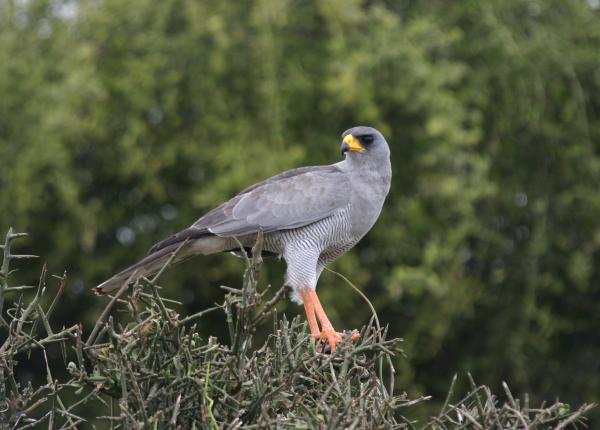Did You Know?
- The Eastern Chanting-goshawk often sits on exposed perches, including the humps of camels!
- Though a diurnal bird of prey, this species does engage in some night-time activity. It will engage in amazing courtship aerial displays at night, with both birds flying together in small circles and vocalizing.
How The Peregrine Fund is Helping
Though The Peregrine Fund doesn't work directly with Eastern Chanting-goshawk, in Kenya, our scientists are working hard to learn about and protect all raptors and their habitats.These efforts will certainly benefit all raptors of the region, including the Eastern Chanting-goshawk.
Meanwhile, our efforts in scientific research, habitat conservation, education, and community development help conserve birds of prey around the world. We also supply literature to researchers from our avian research library, which helps scientists around the world gather and share important information on raptor conservation. We also run the Global Raptor Impact Network which gives raptor researchers tools to more efficiently conduct their own studies while contributing to a global program. GRIN also provides citizen scientists a way to participate in raptor science and conservation.
Where They Live
The Eastern Chanting-goshawk is found in the east of the continent of Africa, namely in parts of Ethiopia, Somalia, Kenya, Uganda and Tanzania.Throughout its range, it inhabits a few different habitats and can be found perching, nesting, and hunting in savanna, steppe, and drier regions.
What They Do
This diurnal raptor spends most time alone or in pairs. If you are ever in Eastern Chanting-goshawk habitat, be sure to scan any exposed perches, where it spends a lot of its time. If you see a raptor with orange feet, a beautiful dark-striped underbelly, yellow cere and slate-grey breast, head and back, you are probably looking at an Eastern Chanting-goshawk. Also, be sure to listen for its repeated calls, which have been described as... chanting of course! Though they have many different types of vocalizations, one particular melodious one is how this bird got its name.
Why They Need Our Help
This goshawk is categorized as Least Concern. It is fairly widespread throughout its range. However, it does still face some threats including loss of habitat due to overgrazing, and tree cutting.
What They Eat
This beautiful goshawk has a long list of prey animals on its menu. It will hunt large insects, such as beetles, small to medium-sized birds (such as doves), and rodents. However, its favorite prey seems to be lizards which it will often snatch up off the ground after swooping down upon them from an exposed perch. Though not common, this species will also feed on carrion from time to time.
Nests, Eggs, and Young
The male and female will work together to build stick nests which they place high up in a leafy tree. They will line their nests with grasses, dung and other materials.
The female will lay 1–2 eggs, which must be incubated for around 36–38 days. The female will carry out the majority of the incubation duties while the male works hard to bring food to the female and to feed himself! When the nestling hatches, it will be covered in a light gray down. They will grow quickly and be ready to leave the nest at around 49–56 days.
Eastern Chanting-goshawk and the World Center for Birds of Prey
Though the World Center for Birds of Prey is far from Eastern Chanting-goshawk territory, another goshawk, the Northern Goshawk can be found in Idaho year-round. They nest in large trees within the Sawtooth National Forest located only a few hours away from The Peregrine Fund's World Center for Birds of Prey. While at the center, we offer fun ways to learn about birds of prey. Interactive activities, tours, interesting videos and a children's room with activities from coloring sheets to quizzes to costumes are all available for our guests. We also have knowledgeable, on-site staff to answer any questions you may have.
References:
Global Raptor Information Network. 2021. Species account: Eastern Chanting Goshawk Melierax poliopterus. Downloaded from http://www.globalraptors.org on 4 Dec. 2021
Kemp, A. C. and G. M. Kirwan (2020). Eastern Chanting-Goshawk (Melierax poliopterus), version 1.0. In Birds of the World (J. del Hoyo, A. Elliott, J. Sargatal, D. A. Christie, and E. de Juana, Editors). Cornell Lab of Ornithology, Ithaca, NY, USA. https://doi.org/10.2173/bow.eacgos1.01










